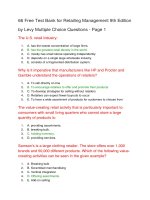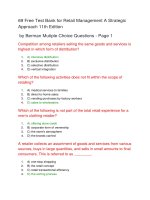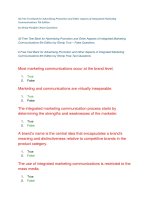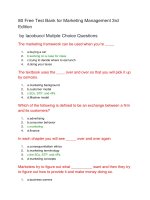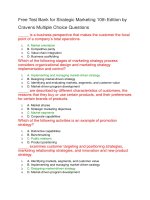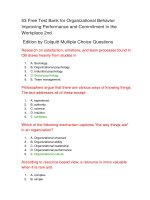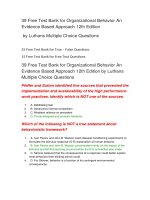60 free test bank for strategic management formulation implementation and control 12th edition
Bạn đang xem bản rút gọn của tài liệu. Xem và tải ngay bản đầy đủ của tài liệu tại đây (74.78 KB, 13 trang )
60 Free Test Bank for Strategic Management
Formulation Implementation and Control 12th Edition
Pearce Multiple Choice Questions - Page 1
(p. 24) Generally, _____ is accepted as the clearest indication of
a firm's ability to satisfy the principal desires of employees and
stockholders.
1.
A. Profit over the long term
2.
B. Profit over the short term
3.
C. Return on assets
4.
D. The number of lawsuits brought against the firm
(p. 21) Which of these is NOT true about the company mission?
1.
A. It embodies the business philosophy of the firm's strategic decision
makers
2.
B. It implies the image the firm seeks to project
3.
C. It provides specific strategies for front-line managers
4.
D. It reflects the firm's self-concept
(p. 24) When the survival goal is taken for granted, therefore
neglected in strategic decision making, the firm's focus shifts to
1.
A. Long run
2.
B. Intermediate run
3.
C. Direction-less activities
4.
D. Short run
(p. 22) Which one of the following is NOT an outcome designed to
be accomplished by a company mission?
1.
A. To provide a unifying purpose for the organization
2.
B. To provide a basis for strategic objective setting
3.
C. To provide a basis for decision making
4.
D. To reward stockholders
(p. 21) Characteristically, the company mission is a statement of
all of these EXCEPT
1.
A. Attitudes
2.
B. Outlooks
3.
C. Measurable targets
4.
D. Orientation
(p. 24) Basing decisions on a short-term concern for profitability
would lead to
1.
A. A reduced market share
2.
B. A strategic myopia
3.
C. A competitive warfare
4.
D. A governmental lawsuit
(p. 24) In a dynamic business environment, ______ is essential.
1.
A. Status quo
2.
B. Compromising ethics in decision making
3.
C. Proactive change
4.
D. Adverse selection
(p. 21) The company mission reflects the firm's
1.
A. Vision
2.
B. Self-concept
3.
C. Corporate governance
4.
D. Agency costs
(p. 24) A firm will be incapable of satisfying its stakeholders'
claims, if it does NOT insure:
1.
A. Growth
2.
B. Survival
3.
C. Profitability
4.
D. Competitive dominance
(p. 22) A mission statement should include all of these
components EXCEPT
1.
A. Basic types of products or services to be offered
2.
B. The firm's managerial philosophy
3.
C. The public image the firm seeks
4.
D. The government regulations the firm must meet
(p. 21) The company mission identifies the
1.
A. Key competitors in the marketplace
2.
B. Board of directors' responsibility towards the owners
3.
C. Specific strategies for gaining market share
4.
D. Scope of its operations in product and market firms
(p. 26) Which of these often reads more like public relations
handouts than the commitment to values they are meant to be?
1.
A. Firm's economic goals
2.
B. Company's self-concept
3.
C. Statement of company philosophy
4.
D. Firm's core competencies and competitive advantage statement
(p. 25) The company mission is a broadly framed but enduring
statement of
1.
A. A firm's intent
2.
B. Corporate structure
3.
C. A firm's competitive positioning
4.
D. Stakeholder analysis
(p. 22) In deriving a mission statement, which of the following
should be included?
1.
A. Tax advantages
2.
B. Secondary markets to be served
3.
C. Concern for survival through growth
4.
D. Employee rules and policies
(p. 24) Profitability is the ______ goal of a business.
1.
A. Mainstay
2.
B. Least important
3.
C. Non economic
4.
D. Subjective
(p. 21) The mission reflects the:
1.
A. Values of the decision makers
2.
B. Goals of the decision makers
3.
C. Experiences of the decision makers
4.
D. Policies of firm
(p. 22) The combination of which of these factors describe the
company's business activities?
1.
A. Basic product or service, primary markets and principal technology
2.
B. Self-concept, managerial philosophy and public image
3.
C. Concern for survival through growth, self-concept and primary markets
4.
D. Economic goals, core competencies and primary and secondary
customers
(p. 24) Which of the following goals are taken for granted to such
an extent that it is neglected as a principal criterion in strategic
decision making?
1.
A. Maturity
2.
B. Ethics
3.
C. Survival
4.
D. Competitiveness
(p. 24) All of these are economic goals that guide the strategic
direction of organizations EXCEPT
1.
A. Survival
2.
B. Market share
3.
C. Profitability
4.
D. Growth
(p. 25) The company's philosophy is sometimes also called the:
1.
A. Company creed
2.
B. Corporate profile
3.
C. Corporate motto
4.
D. Corporate symbol
(p. 22) Three indispensable components of the mission
statements are:
1.
A. Basic product or service, primary markets and principal technology
2.
B. Self-concept, managerial philosophy and public image
3.
4.
C. Concern for survival through growth, self-concept and primary markets
D. Economic goals, core competencies and primary and secondary
customers
(p. 24) Growth means:
1.
A. Change
2.
B. Stability
3.
C. Effectiveness
4.
D. Efficiency
(p. 21) The mission:
1.
A. Sets policy
2.
B. Describes the firm's product
3.
C. Identifies stakeholders
4.
D. Creates the board of directors
(p. 21) The unique purpose that sets a company apart from others
of its type and identifies the scope of its operations. In product,
market and technology terms is defined as the
1.
A. Adverse selection
2.
B. Company mission
3.
C. Moral hazard problem
4.
D. Vision statement
(p. 22) The process of defining the company mission for a specific
business can be best understood by
1.
A. Thinking about the business at its inception
2.
B. Looking at the industry attributes
3.
C. Analyzing the regulatory requirements of what to include in a mission
4.
D. Analyzing the most successful competitors in the marketplace
(p. 22) In general terms, the mission statement addresses all of
the following questions EXCEPT
1.
2.
A. What are our economic goals?
B. What is our operating philosophy in terms of quality, company image and
self-concept?
3.
C. What customers do and can we serve?
4.
D. Who are our competitors and how can we collaborate with them?
(p. 22) In general terms, which of the following questions is
addressed by the mission statement?
1.
A. How should we price our products?
2.
B. What are our economic goals?
3.
C. Which employees should we hire?
4.
D. What leverage structure should we follow?
(p. 25) The statement which usually accompanies the mission
statement and expresses the firm's basic beliefs, values and
aspirations is known as:
1.
A. Grand strategy
2.
B. The company's statement of philosophy
3.
C. The company profile
4.
D. Long-term objectives
(p. 21) The mission statement is a message designed to be
inclusive of the expectations of _______ stakeholders for the
company's performance over the ______.
1.
A. All; long run
2.
B. Only key; short run
3.
C. All; short run
4.
D. Only key; long run
(p. 22) When should a company redefine its mission?
1.
A. When the competition have failed
2.
B. When the board meets with top management annually
3.
4.
C. When the business is forced by competitive pressures to alter its
products of market
D. When the government requires the business to redefine it
60 Free Test Bank for Strategic Management
Formulation Implementation and Control 12th Edition
Pearce Multiple Choice Questions - Page 2
(p. 35) A set of ideas on organizational control based on the belief
that the separation of the ownership from management creates
the potential for the wishes of owners to be ignored refers to the
1.
A. Agency theory
2.
B. Adverse selection principle
3.
C. Moral hazard problem
4.
D. Self concept
(p. 29) The essence of the company self-concept is the idea that
1.
A. The firm's public image is positive
2.
B. The firm must know itself
3.
C. The firm must know the industry
4.
D. The firm's economic goals must be aligned with the industry's top
competitor
(p. 34) Which of these is NOT a responsibility of the board of
directors?
1.
A. To establish and update the company mission
2.
B. To mandate company compliance with legal and ethical dictates
3.
4.
C. To determine the amount and timing of the dividends paid to
stockholders
D. To work under the guidance of the CEO
(p. 34) The strategic decision makers in the firm are responsible
for:
1.
A. The firm's mission
2.
B. Rewards
3.
C. Plant efficiency
4.
D. Daily operations
(p. 30) Three issues have become prominent in the strategic
planning for organizations and are increasingly becoming integral
parts in the development and revisions of mission statements.
These are:
1.
A. Self-concept, customers and markets
2.
B. Customers, quality and vision statement
3.
C. Markets, quality and concern for employees
4.
D. Concern for employees, suppliers and customers
(p. 33) Mission statement expresses an answer to which of these
questions?
1.
A. How do we compete in this industry?
2.
B. What business are we in?
3.
C. Who are our competitors?
4.
D. How do we meet the regulatory requirements?
(p. 31) "The customer is our top priority" is a
1.
A. Mission statement
2.
B. Concern for quality
3.
C. Slogan
4.
D. Vision statement
(p. 34) In overseeing the management of a firm, the board of
directors operates as representatives of the
1.
A. Governmental agencies
2.
B. Firms stockholders
3.
C. Firms employees
4.
D. Top management
(p. 28) A major determinant of a firm's success is the extent to
which it can relate functionally to the external environment. To
accomplish this the firm must have:
1.
A. Infinite sources of capital for expansion
2.
B. A realistic self-concept
3.
C. Specific objectives and job descriptions
4.
D. Community involvement
(p. 36) Which of these represent the most popular solution to
moral dilemma and adverse selection problems?
1.
A. To more closely align the owners and agents interests through the use of
executive bonus plans
2.
B. To allow the managers to act more as hired-hands only
3.
C. To remove vision components from mission
4.
D. To ensure board of directors report and work for the CEO
(p. 27) The image the company seeks to project is reflected in the
firm's:
1.
A. Profile
2.
B. Tactics
3.
C. Mission
4.
D. Strategic options
(p. 34) The strategic managers at the highest level of the
organization:
1.
A. Review employee complaints
2.
B. Declare the firm's sense of values
3.
C. Are appointed
4.
D. Prepare budgets
(p. 34) Which group of strategic managers is responsible for
overseeing the creation and accomplishment of the company
mission?
1.
A. Front-line supervisors
2.
B. Middle-managers
3.
C. Board of directors
4.
D. Employees
(p. 29) Trading Tools performs an extensive evaluation of its
competitive strengths and weaknesses. This effort is directed
towards determining its
1.
A. Vision
2.
B. Economic goals
3.
C. Public image
4.
D. Self-concept
(p. 30) Which of these is the newest trend in mission
components?
1.
A. Sensitivity to customer wants
2.
B. Concern for suppliers and distributors
3.
C. Inclusion of both positive and negative aspects of public image
4.
D. Aligning the firm's self-concept to that of competitor's
(p. 32) Which of these is one of Demming's well-known points on
quality?
1.
A. Create dependence on mass inspections to achieve quality
2.
B. Award business on the measure of price tag
3.
C. Breakdown barriers between departments
4.
D. Corporate transformation should be the responsibility of top
management
(p. 35) In general, ____ seek stock value maximization.
1.
A. Employees
2.
B. Hired-hand managers
3.
C. Owners
4.
D. Suppliers and distributors
(p. 35) When owners have limited access to company information
making executives free to pursue their own interests refers to
1.
A. Moral hazard problems
2.
B. Adverse selection
3.
C. Self-concept
4.
D. Concern for quality
(p. 35) An agency problem caused by the limited ability of
stockholders to precisely determine the competencies and
priorities of executives at the time they are hired refers to
1.
A. Self-concept
2.
B. Adverse selection
3.
C. Moral hazard problem
4.
D. Concern for quality
(p. 31) Which two U.S. management experts fostered a worldwide
emphasis on quality in manufacturing?
1.
A. Bill Gates and John Allison
2.
B. Gary Forsee and Mr. Penney
3.
C. Bill Gates and E. Demming
4.
D. W. Edwards Demming and J. M. Juran
(p. 32) All of these are Demming's well known points on quality
EXCEPT:
1.
A. Drive out fear
2.
B. Create slogans, exhortations and numerical targets
3.
C. Institute a rigorous program of education and self-improvement
4.
D. Create constancy of purpose
(p. 33) _______ represents a statement that presents a firm's
strategic intent designed to focus the energies and resources of
the company on achieving a desirable future.
1.
A. Mission statement
2.
B. Agency theory
3.
C. Adverse selection
4.
D. Vision statement
(p. 36-37.) Which of the following is NOT a problem resulting from
agency?
1.
A. Executive attempt to diversify their corporate risk
2.
B. Executives avoid risks
3.
C. Executives pursue growth in company earnings rather than size
4.
D. Executives act to protect their status
(p. 33) Where as ______ expresses an answer to the question
"What business are we in?" a company ____ is developed to
express the aspirations of the executive leadership.
1.
A. Mission statement; vision statement
2.
B. Economic goals; self concept
3.
C. Vision statement; mission statement
4.
D. Self-concept; economic goals
(p. 37) Which of these represent a solution to the agency
problem?
1.
A. Backloaded compensation for executives
2.
B. Separate the interests of the owners and agents
3.
C. Minimize executive risk-taking
4.
D. Focus performance measures on personal goals of executives
(p. 27) Which of the following statements about public image is
FALSE?
1.
A. Negative public image often prompts firms to reemphasize the beneficial
aspects of their mission
2.
B. The image the company seeks to project should be reflected in its
mission
3.
C. Firms always address the question of their public image in an
intermittent fashion
4.
D. Concern for public image is an important components of a firm's mission
(p. 34) The board of director's greatest impact on the behavior of
a firm results from its
1.
A. Industry experience
2.
B. Dependence on the CEO
3.
C. Determination of company mission
4.
D. Mandate of company compliance with legal and ethical dictates
(p. 35) The cost of agency problems and the cost of actions taken
to minimize them are called
1.
A. Moral hazard problems
2.
B. Adverse selection
3.
C. Company creed
4.
D. Agency costs
(p. 37) Backloaded compensation refers to
1.
A. Board of directors getting back stock as compensation
2.
B. Executives receiving handsome premium for superior future performance
3.
C. Suppliers getting bonuses for organization's performance
4.
D. Managers getting bonuses for past performances
(p. 25) Given that managers implicitly accept a general, unwritten,
yet pervasive code of behavior that govern business actions, the
_____ vary little from one firm to another.
1.
A. Philosophies
2.
B. Visions
3.
C. Missions
4.
D. Self-concepts
